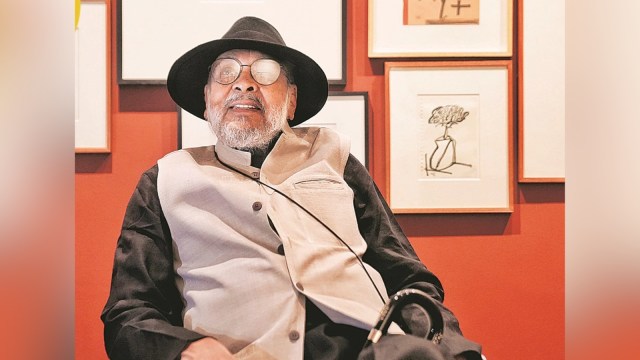Veteran artist Himmat Shah passes away at 91
Born into a Jain mercantile family in Lothal (Gujarat) — the visiting archeologists and historians captivated Himmat Shah's attention as much as the travelling theatrical troupes and potters at their wheels.
 Himmat Shah at his show in Bikaner House, New Delhi. (Photo credit: Abhinav Saha)
Himmat Shah at his show in Bikaner House, New Delhi. (Photo credit: Abhinav Saha)In an art world that boasts several iconoclasts, Himmat Shah blazed an unmatched trail. For him, every material was imbued with life — whether it was charred paper, which he transformed in his collages, or clay that he meticulously ground by hand and soaked in water for years to fortify its strength. His studio in Jaipur stood as a veritable laboratory of found objects — from old bottles to wires and ropes — each destined to be transformed and granted an afterlife. However, that endeavour will remain unfulfilled, as Shah passed away on March 2. He was 91.
“In the history of Indian sculpture, I would regard him as ‘The Sculptor’. He always saw himself as an eternal student of art, constantly searching, forever experimenting and pushing boundaries,” says artist GR Iranna, who has known Shah since the 1990s, when both of them worked at Garhi studios in Delhi.
While his slip-casting technique for terracotta and ceramic gained wide recognition, so did his ‘silver paintings,’ made with plaster of Paris and sand, adorned with silver paint and silver leaf (warq). It was memories of playing in the pond with his friends as a child that inspired his celebrated stylised heads in bronze that first appeared in the early 2000s.
Though he earned much acclaim for his work throughout his career, it took several years for his financial fortunes to change. “True to his name, Himmat was all courage and spirited. Extremely feisty, he lived the life of an artist who was completely immersed in the joy of creation and expression. His in-depth and perceptive way of understanding and looking at the world with an acute sense of observation and sensitivity transformed magically in his art. To him, the answers of life only came through his art,” says Roobina Karode, director and chief curator at Kiran Nadar Museum of Art (KNMA). A close friend of Shah, she also curated his 2016 retrospective “Hammer of the Square” at KNMA. She adds, “The idea of becoming fearless to create was paramount to him; he believed that unless you could free yourself from the fear of how the world will treat you, whether your art will be successful or would you be accepted by your peers, your creativity will remain constrained. He considered these shackles.”
Born into a Jain mercantile family in Lothal (Gujarat) — a flourishing port town during the Indus Valley Civilization — the visiting archeologists and historians captivated his attention as much as the travelling theatrical troupes and potters at their wheels. He was still in his pre-teens when he decided to flee from home, boarding a train to Junagadh, and finally finding his way to Ahmedabad, where he studied at CN Kalaniketan under the guidance of veteran artist Rasiklal Parikh. In the early ’50s, he enrolled in a drawing teacher’s course at the Sir JJ School of Art in Mumbai, followed by a stint at Maharaja Sayajirao University in Baroda, where his teachers included notable figures such as NS Bendre, Sankho Chaudhuri and KG Subramanyan. Arriving in Delhi in 1962, he was a core member of the short-lived yet influential Group 1890, that also included J Swaminathan and Jeram Patel.
Though a French government scholarship to study under artists SW Hayter and Krishna Reddy at the renowned printmaking studio Atelier 17 in Paris in 1966 also allowed him the opportunity to closely observe the works of Western masters in the European museums, he returned to India to develop his own distinctive vocabulary, exploring new forms and materials, including creating brick and cement relief murals at Saint Xavier’s school in Ahmedabad, designed by his architect-friend Hasmukh Patel.
Having known Shah since the mid ’90s, when he first interacted with him for his MFA dissertation at MS University, artist Jagannath Panda notes, “He was a spiritual seeker who wanted his viewers to look at art as an experience, not a product.” He adds how Shah’s art was also a reflection of the simple life he led. “He was warm and curious, his responses come from the heart,” adds Panda. Iranna states, “He never imparted book knowledge but shared his own experiences, from which there was so much to learn.”
On his constant quest to make new discoveries, speaking to The Indian Express in 2024, Shah had noted: “My work is my weapon, and I regard creativity as the greatest celebration; there is no greater tool. It is not merely an act of the mind; it is an act of the body. Art can only be understood through the gestures of the body. The possibilities are endless. I am still striving to discover my own sculpture; it has not yet been born.”







